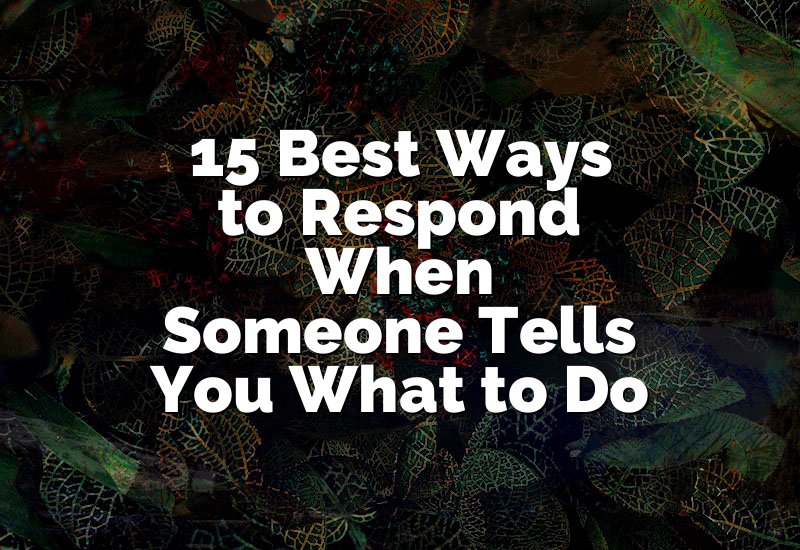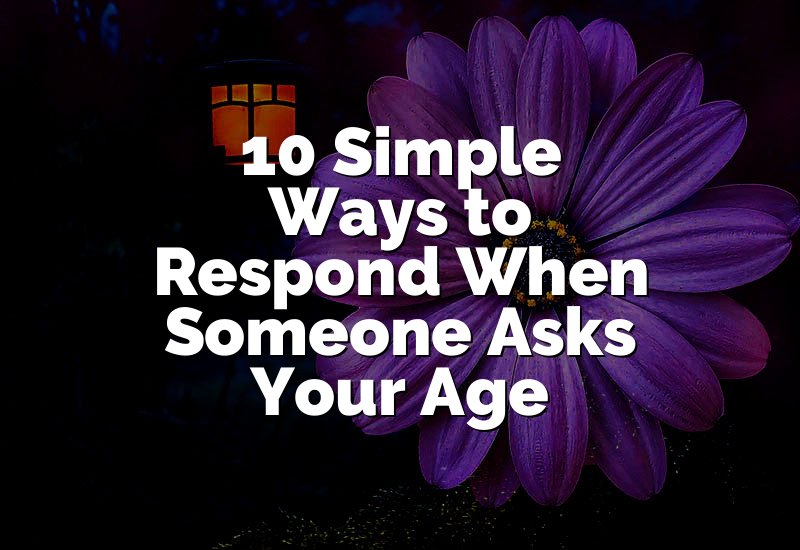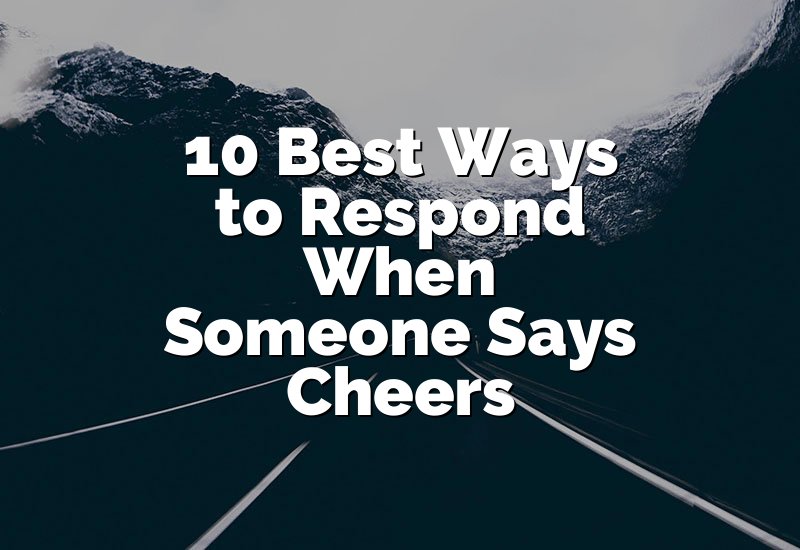Sometimes people like to tell us what to do. It can happen at work, at home, or even with friends. For example, a boss may say "You should do it this way" or a family member may try to control your choices. Learning how to answer calmly and smartly can make a big difference. In this article, we will talk about simple ways to respond.
1. Stay Calm Before You Answer
When someone tells you what to do, the first thing is to stay calm. If you react too fast, you may say something you regret. Take a small breath before speaking. Staying calm helps you think clearly and answer in a way that does not create more problems. It is like putting a pause button on your emotions. By keeping your cool, you also show others that you are in control of yourself.
- "I hear you, let me think about it."
- "Thanks, I'll take a moment before I decide."
- "I'll keep calm and respond in a minute."
- "I appreciate your idea, I'll consider it."
- "I need a second to think."
- "Let me breathe before I answer."
- "Okay, I understand your point."
- "I'll respond when I'm ready."
- "That's something to think about."
- "I'm listening, give me a moment."
2. Say Thank You Without Agreeing
Sometimes the best way to respond is by saying thank you, even if you do not agree. Saying thank you shows respect but does not mean you must follow their words. It makes the other person feel heard, but you can still decide on your own path. It is polite, simple, and avoids conflict. This way you protect your peace while keeping things friendly.
- "Thank you for sharing your thoughts."
- "I appreciate your advice."
- "Thanks, I'll think about it."
- "I'm grateful for your input."
- "Thank you for telling me."
- "I value your opinion."
- "I'll keep that in mind, thank you."
- "That's helpful, thanks."
- "Thank you for caring enough to say that."
- "I appreciate the time you took to tell me."
Also Read: 32 Great Responses When a Guy Winks at You
3. Use Humor to Lighten the Mood
Humor can be a great way to handle people who tell you what to do. A small funny comment can break the tension and make the situation lighter. It helps keep things friendly without making it too serious. When you use humor, people may laugh and the mood changes quickly. Just make sure the humor is kind and not rude, so the other person does not feel offended.
- "Are you my new boss now?"
- "Oh, do I look like I need a life coach?"
- "I'll add that to my long to-do list!"
- "Thanks, I'll check my instruction manual."
- "Did I hire you as my advisor?"
- "Haha, I'll think about that one."
- "Oh, so now you're in charge?"
- "That's funny, I'll see if I can manage."
- "I'll see if my brain approves that."
- "Looks like you have a lot of good orders today!"
4. Be Honest About Your Feelings
If you feel uncomfortable, it is okay to say so. Being honest lets people know how their words affect you. Many times, they may not even realize they are bossing you around. By sharing your feelings, you set boundaries and help them understand your side. Honesty is always better than keeping it inside, because it avoids misunderstandings later.
- "I feel pressured when told what to do."
- "It makes me uncomfortable when you say that."
- "I prefer deciding for myself."
- "I need to do it in my own way."
- "I respect you, but I want space to choose."
- "That feels a little controlling to me."
- "I want to try my way first."
- "It bothers me when people direct me."
- "I like advice, but not orders."
- "I'd rather figure this out myself."
5. Ask for Clarification
Sometimes people do not mean to boss you around, they just want to help. If you are not sure, ask them what they really mean. Asking for clarification helps clear confusion. It also gives you time to think. When you ask questions, you also show that you are listening but not blindly following. It makes the conversation more open and easier to handle.
- "Can you explain what you mean?"
- "Do you mean this as advice or an order?"
- "What makes you think I should do it that way?"
- "Can you tell me why you suggest that?"
- "Are you just sharing or telling me to do it?"
- "Do you think this is the only way?"
- "Why do you feel strongly about this?"
- "Are you advising or directing me?"
- "Can you explain more clearly?"
- "What's the reason behind your suggestion?"
6. Offer Your Own Perspective
When someone tells you what to do, you can share your side too. Offering your perspective shows that you are thinking for yourself. It also makes the conversation balanced. Instead of just receiving their words, you give back your own thoughts. This helps others see your point and respect your choice. It builds confidence and shows independence.
- "That's one way, but I prefer my way."
- "I see your point, here's my view."
- "That works, but I'd like to try this."
- "Interesting, but I think differently."
- "I understand, but I'll go with my choice."
- "Good idea, but I have another plan."
- "I get it, but I want to test my way."
- "That could work, but here's my thought."
- "I respect your view, here's mine."
- "I'd rather handle it differently."
7. Set Boundaries Politely
Sometimes people keep telling you what to do because you allow it. Setting boundaries is a healthy way to stop it. You can say no politely and make it clear that you want space. When you set boundaries, you protect your energy and choices. It may feel hard at first, but with practice, it becomes easier. People will start respecting your limits.
- "I'd prefer to decide myself."
- "Thanks, but I'll do it my way."
- "I want to handle this alone."
- "I'm not looking for advice right now."
- "Please let me choose for myself."
- "I need space to figure this out."
- "I'd rather not be told what to do."
- "Thanks, but I'll manage on my own."
- "I want to trust my own judgment."
- "Let me do this in my own style."
8. Agree If It Helps You
Not every suggestion is bad. Sometimes what they say is useful. In such cases, you can agree and follow it if it makes sense. Agreeing does not mean you are weak, it means you are smart enough to take good advice. It saves you time and helps you learn from others. Just make sure you are agreeing by choice, not by pressure.
- "That's a good idea, I'll try it."
- "I agree with you on this."
- "That makes sense, I'll do it."
- "I think you're right."
- "I'll follow that advice."
- "That sounds like a smart way."
- "I'm okay with your suggestion."
- "Yes, that works for me."
- "I'll go with that plan."
- "I agree, that's helpful."
9. Change the Topic Smoothly
If you do not want to argue, you can change the topic. This helps avoid conflict and moves the conversation in another direction. It is an easy trick to keep things light and stop people from pushing their ideas on you. By smoothly shifting topics, you control the flow of the talk without being rude. It works well in casual situations.
- "By the way, how was your day?"
- "Let's talk about something fun."
- "Oh, did you hear the news today?"
- "That reminds me, I have a story."
- "Anyway, what are your weekend plans?"
- "Speaking of that, how's your project going?"
- "Let's move on to something else."
- "I'd like to talk about a new topic."
- "Oh, that makes me think of something funny."
- "Let's change the subject for now."
10. Walk Away If Needed
Sometimes the best response is to not respond at all. If the situation feels too much, walking away is powerful. It shows that you do not need to stay in a space where someone is controlling you. Walking away is not weakness, it is self-respect. It gives you peace and avoids bigger conflict. Sometimes silence speaks louder than words.
- "I'll continue this later."
- "Excuse me, I need to step out."
- "I don't want to talk about this right now."
- "Let's pause this conversation."
- "I need a break from this."
- "I'll walk away for now."
- "This is not the right time."
- "I'll think about it on my own."
- "I need some space."
- "I'm going to step back for a while."
Final Thoughts
When someone tells you what to do, you always have choices. You can respond calmly, politely, or with humor. You can agree if it helps, or set boundaries when needed. The main point is to stay true to yourself and protect your peace. With practice, responding becomes easier and less stressful. Respect yourself first, and others will learn to respect you too.
| Way to Respond | When to Use | Example Sentence |
|---|---|---|
| Stay Calm | When emotions are high | "I hear you, let me think about it." |
| Say Thank You | When you want to be polite | "Thank you for sharing your thoughts." |
| Use Humor | To lighten the mood | "Are you my new boss now?" |
| Be Honest | When you feel uncomfortable | "I prefer deciding for myself." |
| Ask Clarification | If you are unsure | "Can you explain what you mean?" |
| Offer Perspective | To share your view | "That's one way, but I prefer my way." |
| Set Boundaries | To protect yourself | "Thanks, but I'll do it my way." |
| Agree If Helpful | When advice is useful | "That's a good idea, I'll try it." |
| Change Topic | To avoid conflict | "By the way, how was your day?" |
| Walk Away | When it's too much | "I'll continue this later." |

Frequently Asked Questions (FAQs)
Is it rude to ignore someone who tells me what to do?
It depends on the situation and how often it happens. Ignoring someone completely can sometimes feel rude to them, especially if they are trying to help with good intentions. But if a person keeps telling you what to do again and again, even after you have made it clear that you do not want their control, then ignoring may be a healthy way to set limits. You can ignore without being harsh. For example, you may just smile, not give an answer, and continue doing what you think is right. That way, you protect your space without creating an argument.
Can I use humor without sounding disrespectful?
Yes, humor can be friendly if you keep it light. The goal of humor is not to insult but to relax the mood. Sometimes people are not even aware that they are being bossy, so a small joke can show them without hurting feelings. For example, if someone keeps saying "Do it like this," you could laugh and say, "Wow, I didn't know I had a new manager today." This kind of playful answer makes them smile but also shows your independence. The key is to use gentle humor, not sarcasm that might sound sharp or mean.
Do I always need to explain myself?
No, you do not always need to explain why you do not follow someone's advice. It is okay to simply say, "Thanks, but I'll handle it my way." Not every choice in life needs a long explanation. Sometimes when we explain too much, it makes us look like we need permission for our actions. You are free to decide for yourself. If you feel comfortable, you can share your reason, but if not, a short polite reply is enough. The important thing is that you feel good about your decision.
Is it okay to say no directly?
Yes, saying no directly is perfectly okay. Being clear is better than agreeing and feeling upset later. Saying no does not mean you are rude; it means you are honest. For example, if someone tells you, "You should do it like this," you can say, "No, thanks. I prefer my own way." This short and simple answer shows respect but also makes your boundary clear. The more you practice saying no politely, the easier it becomes over time, and people will learn to accept it.
Can agreeing sometimes make things easier?
Yes, agreeing can make things easier, especially when the advice is good. Not every piece of advice is controlling. Sometimes people truly share helpful ideas. If what they say can save you time or effort, it makes sense to agree. For example, if someone says, "It's better to take this road because there's less traffic," agreeing can save you from stress. The key is that you agree because you choose to, not because you feel forced. Agreeing is smart when it helps you.
Do I need to defend myself every time?
No, you don't need to defend yourself every time someone tells you what to do. Constantly defending can make you feel tired. Sometimes the best answer is silence, or a simple thank you without debate. If you defend every time, it may create conflict where it is not needed. You should choose when to explain and when to stay quiet. Pick your battles wisely. Protect your peace instead of trying to prove your point all the time.
Is it better to just walk away?
Yes, sometimes walking away is the best choice. If the person is too controlling or the situation feels heated, leaving can save your peace. Walking away is not weakness. It is a strong way of saying you will not take unnecessary pressure. When you step back, you avoid saying something you may regret. You can always return to the talk later if it feels right. Walking away gives you space to calm down and think clearly.
Can I still stay polite while setting boundaries?
Yes, you can be polite and still set firm boundaries. Being polite means you use kind words, but being firm means you stick to your choice. For example, you can say, "Thank you for your advice, but I'll handle it myself." This sounds respectful but also clear. People may test your boundaries at first, but if you keep repeating your limits calmly, they will start to respect you. Polite boundaries are powerful because they protect your space without creating anger.









